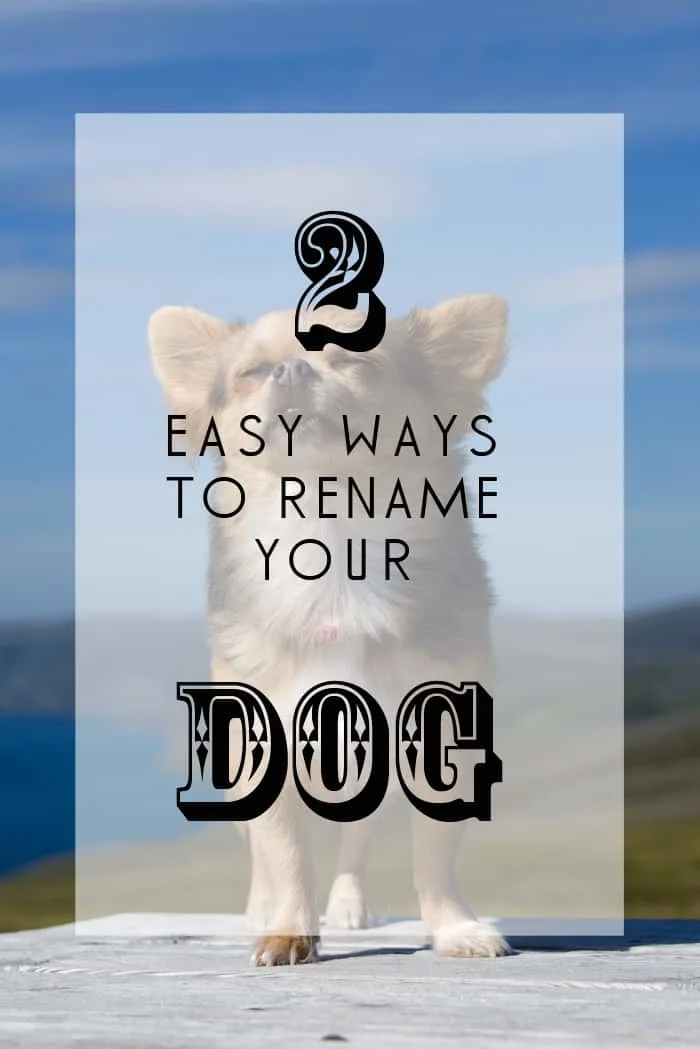Should you rename your newly-adopted dog if you don’t like his or her name? Whether you are looking at renaming a puppy or an older dog, changing your dog’s name is easier than you might think. We’ve got two easy techniques to use if you are looking for how to rename a dog.
Let’s face it: some names just don’t roll off our tongues with ease. Other names bring up unpleasant memories of previous connections. And some names just don’t seem a good fit for your newest family member. Whatever the reason, if your new dog’s name doesn’t bring a smile to your face, it’s time for a change!

Changing Our Dogs’ Names
In all our years of adopting cats and dogs, we’ve only kept the shelter name for one of our pets. Yoda, a Terrier mix, came to us with his name that seemed just right for the wise and spritely little fellow that he was.

In every other case, however, we’ve changed our pet’s shelter name. Irie was originally known as Abby. Tiki was Doris. Barli was Baby Bear.
Our cats have also had a name switcheroo: Inca was originally Snitch, Lucky was Tuxie, Ochi was Gummy Bear, Jetty was Sunday.
None of the names fit the personalities that we were discovering in the early days after their adoption.
Can you change your dog’s name after adoption?
Should you change your dog’s shelter name after adoption? In many cases, it’s really a non-issue because often the dogs don’t really know their shelter names.
Irie and Tiki didn’t react at all when we called them by their shelter monikers. Like all our other dogs and cats, both Irie and Tiki were previous strays so they had no attachment to their newly-given shelter names.
Barli had the longest shelter stay (three months) of any of our dogs but he, too, didn’t react when we called his shelter name.
Although shelter personnel call the dogs by their shelter names, those shelter names are most often used for recordkeeping and to promote the pet on the shelter’s website, Petfinder, Adopt-a-Pet, and more–so your newly-adopted dog may not recognize his moniker.
When should you NOT change your dog’s name?
There are two situations when you might not want to immediately change your dog’s name:
- If your dog was living in a foster home situation. If he had a fairly long foster home stay, he may know his given name.
- If your dog’s previous owner passed away.
Both of those situations can mean your dog is attached to his name–but, even then, it doesn’t mean that you have to stick with that name forever, just that you’ll want to transition to a new name with one of the techniques below.
If your dog knows his previous name and you’d like to change it, you’ll want to gradually fade out the old name and introduce the new name. There are two easy tricks for making the transition:
Method #1: Use a Double Name for a While
Try a double name while your dog makes the transition.
If your dog was named Tommy and you want to name him Jake, he can become Tommy Jake. After a period of using both names, just start calling your dog Jake.
Don’t Miss: Repetitive Dog Names: Easy Two-Syllable Names Your Dog Will Learn Quickly!
Method #2: Rename with a Rhyming Name
Another solution is to choose a new name that rhymes with the old name.
Jerry can become Harry, Bella came become Nella. It’s super easy…yes, easy peasy…to change your dog’s name this way.
Showing Your Dog His New Name Means Happy Times!
Regardless of the method you choose to change your dog’s name, be sure to associate your dog’s new name with lots of praise and joy–and some tasty training treats will help, too.
Use some treats he REALLY likes and cut them into small (pea-sized) pieces.
With the treats in your hand, take your dog to a quiet place where you’ll have his full attention. He should have already exercised and relieved himself so there are no distractions.
When your dog looks at you, say his name once then immediately give him a treat and say “Good!” in a very enthusiastic tone. (If you’ll be training with a clicker, immediately click the clicker and give the treat.)
Wait for your dog to look away then again say his name one time. As soon as you have eye contact, again give him a treat and an enthusiastic “Good!” (and a click, if you’re clicking).
Take a few steps away to change the angle between you and your dog and repeat the exercise. Work with him for about five minutes.
If you’re not successful, make sure there are no distractions in the area and make sure your puppy has already been exercised.
Also, giving your puppy a peek at the treat in your hand and the chance to sniff it can be a help.
Finally, don’t schedule the training session (or any training session) right after his feeding time; the motivation of a yummy treat is important!
Associating your dog’s new name with good things and happy times will help your new dog learn his new name and, most importantly, the place he holds in his new forever home.
FAQ About Changing Your Dog’s Name
Can You Rename a Dog?
Wondering if you can rename a dog? The answer is definitely yes!
Whether you are adopting a new dog who may come with an existing name or you name your dog then just don’t feel like it “sticks,” you can change your dog’s name using either of the methods above.
Is it bad to change a dog’s name?
A new name can signal a new start–sometimes a good decision for your pet’s happiness and for the success of future training.
If your new dog or cat came from an abusive situation, that name may be tied to memories of bad times–times when his previous owner called him in anger. In that case, it’s always better to rename.
Or your decision to change your pet’s assigned name may be based solely on your own personal likes and dislikes. (Who wants a dog that shares a name with an ex? Or that boss you couldn’t tolerate?) That’s OK, too. You want your dog’s name to make you smile–and that will make your dog happy, too!
Pin it to remember How to Rename Your New Dog

- Review: Jimmy BX7 Pro Anti-Mite Vacuum Cleaner - December 16, 2024
- 🎉 GIVEAWAY: Lord of the Pets Portrait of Your Dog! - November 26, 2024
- Review: Lord of the Pets Portraits - November 17, 2024
